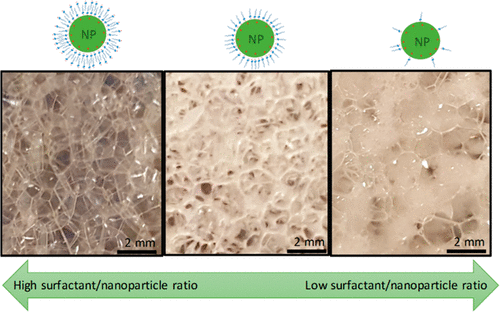Our official English website, www.x-mol.net, welcomes your
feedback! (Note: you will need to create a separate account there.)
Insight on Methane Foam Stability and Texture via Adsorption of Surfactants on Oppositely Charged Nanoparticles
Langmuir ( IF 3.7 ) Pub Date : 2018-10-29 00:00:00 , DOI: 10.1021/acs.langmuir.8b01966 Mina Doroudian Rad 1 , Ali Telmadarreie 1 , Long Xu 1, 2 , Mingzhe Dong 1 , Steven L. Bryant 1
Langmuir ( IF 3.7 ) Pub Date : 2018-10-29 00:00:00 , DOI: 10.1021/acs.langmuir.8b01966 Mina Doroudian Rad 1 , Ali Telmadarreie 1 , Long Xu 1, 2 , Mingzhe Dong 1 , Steven L. Bryant 1
Affiliation

|
We report the phase behavior of a dispersion of alumina-coated silica nanoparticles in the presence of an anionic surfactant (sodium fatty alcohol polyoxyethylene ether sulfate), and then describe the influence of surfactant/nanoparticle concentration ratio on the stability of methane foam as a potential fluid for enhanced oil recovery application. The surface tension of the methane/aqueous phase interface, surface charge, and size of the particle aggregates and amount of surfactant adsorption were characterized as a function of surfactant/nanoparticle ratio. Five adsorption stages, which are described in terms of the extent and type of the surfactant coverage on the nanoparticle surface, explain the behavior of the solution at different surfactant/nanoparticle ratios. The static foam generation experiments were conducted to monitor the variation of the foam stability and texture over the defined adsorption stages. The surface tension trends illustrate that the affinity of nanoparticles for the gas–liquid interface is strongly affected by the adsorption extent of AES molecules on the particle surface. At high surfactant/nanoparticle ratio, the adsorbed surfactant bilayer causes a high hydrophilicity of the particles that significantly pushed the particles away from the gas–liquid interface. At the most hydrophobic state of the particles which occurred at the ratio of 0.2, the foam structure collapsed quickly. The most stable foam with fine texture was found at surfactant/nanoparticle ratio less than 0.008 at which the particles are partially covered with surfactants and have smaller aggregate size. The findings provide a better understanding of the interaction between oppositely charged nanoparticle/surfactant pairs and how that interaction affects foam stability. It is demonstrated that substitution of absolute concentration by surfactant/nanoparticle ratio can truly govern the foam stability and texture. The results can be beneficial to predict the foam behavior in its numerous applications and whether interactions will be synergistic, antagonistic, or neutral.
中文翻译:

通过表面活性剂在相反电荷的纳米粒子上吸附对甲烷泡沫的稳定性和织构的认识
我们报告了在阴离子表面活性剂(脂肪醇聚氧乙烯醚硫酸钠)存在下氧化铝包覆的二氧化硅纳米颗粒分散体的相行为,然后描述了表面活性剂/纳米颗粒浓度比对甲烷泡沫稳定性的潜在影响。流体以提高采油率。甲烷/水相界面的表面张力,表面电荷,颗粒聚集体的大小和表面活性剂的吸附量是表面活性剂/纳米颗粒比例的函数。根据表面活性剂在纳米颗粒表面的覆盖程度和类型来描述的五个吸附阶段解释了溶液在不同表面活性剂/纳米颗粒比率下的行为。进行静态泡沫产生实验以监测在限定的吸附阶段泡沫稳定性和质地的变化。表面张力趋势表明,纳米粒子对气液界面的亲和力受粒子表面上AES分子的吸附程度的强烈影响。在高的表面活性剂/纳米颗粒比率下,吸附的表面活性剂双层会导致颗粒的高亲水性,从而将颗粒从气液界面上明显推开。在以0.2的比率出现的颗粒的最疏水状态下,泡沫结构迅速塌陷。在表面活性剂/纳米颗粒之比小于0.008时,发现具有优良质地的最稳定的泡沫,在该比例下,颗粒被表面活性剂部分覆盖并且聚集体尺寸较小。该发现提供了对带相反电荷的纳米颗粒/表面活性剂对之间的相互作用以及该相互作用如何影响泡沫稳定性的更好的理解。结果表明,用表面活性剂/纳米粒子比率代替绝对浓度可以真正控制泡沫的稳定性和质地。该结果对于预测泡沫在其众多应用中的行为以及相互作用是协同,拮抗还是中性的都是有益的。
更新日期:2018-10-29
中文翻译:

通过表面活性剂在相反电荷的纳米粒子上吸附对甲烷泡沫的稳定性和织构的认识
我们报告了在阴离子表面活性剂(脂肪醇聚氧乙烯醚硫酸钠)存在下氧化铝包覆的二氧化硅纳米颗粒分散体的相行为,然后描述了表面活性剂/纳米颗粒浓度比对甲烷泡沫稳定性的潜在影响。流体以提高采油率。甲烷/水相界面的表面张力,表面电荷,颗粒聚集体的大小和表面活性剂的吸附量是表面活性剂/纳米颗粒比例的函数。根据表面活性剂在纳米颗粒表面的覆盖程度和类型来描述的五个吸附阶段解释了溶液在不同表面活性剂/纳米颗粒比率下的行为。进行静态泡沫产生实验以监测在限定的吸附阶段泡沫稳定性和质地的变化。表面张力趋势表明,纳米粒子对气液界面的亲和力受粒子表面上AES分子的吸附程度的强烈影响。在高的表面活性剂/纳米颗粒比率下,吸附的表面活性剂双层会导致颗粒的高亲水性,从而将颗粒从气液界面上明显推开。在以0.2的比率出现的颗粒的最疏水状态下,泡沫结构迅速塌陷。在表面活性剂/纳米颗粒之比小于0.008时,发现具有优良质地的最稳定的泡沫,在该比例下,颗粒被表面活性剂部分覆盖并且聚集体尺寸较小。该发现提供了对带相反电荷的纳米颗粒/表面活性剂对之间的相互作用以及该相互作用如何影响泡沫稳定性的更好的理解。结果表明,用表面活性剂/纳米粒子比率代替绝对浓度可以真正控制泡沫的稳定性和质地。该结果对于预测泡沫在其众多应用中的行为以及相互作用是协同,拮抗还是中性的都是有益的。


















































 京公网安备 11010802027423号
京公网安备 11010802027423号